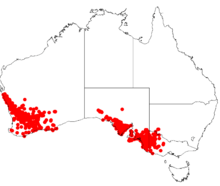Boronia coerulescens
Boronia coerulescens, commonly known as blue boronia,[2] is a plant in the citrus family, Rutaceae and is endemic to southern Australia. It is a small, spindly shrub with glandular stems, small, more or less cylindrical leaves and blue to pinkish mauve, four-petalled flowers. There are two subspecies endemic to Western Australia and a third that also occurs in three eastern states.
| Blue boronia | |
|---|---|
 | |
| Boronia coerulescens in the Little Desert National Park | |
| Scientific classification | |
| Kingdom: | Plantae |
| Clade: | Tracheophytes |
| Clade: | Angiosperms |
| Clade: | Eudicots |
| Clade: | Rosids |
| Order: | Sapindales |
| Family: | Rutaceae |
| Genus: | Boronia |
| Species: | B. coerulescens |
| Binomial name | |
| Boronia coerulescens | |
 | |
| Occurrence data from Australasian Virtual Herbarium | |
Description
Boronia coerulescens is an erect shrub that grows to a height of 0.2–0.6 m (0.7–2 ft) with branchlets that are warty glandular. The leaves are usually simple, (sometimes with three lobes), more or less cylindrical in shape to narrow oblong or elliptic, 5–10 mm (0.20–0.39 in) long and 0.5–1.5 mm (0.020–0.059 in) wide. The flowers are bright blue, lilac-coloured or white and are arranged singly in leaf axils or in dense, leafy spikes on the end of the branches. Each flower has a pedicel 2–5 mm (0.08–0.2 in) long. The four sepals are triangular to broadly egg-shaped, 1.5–7 mm (0.06–0.3 in) long with their bases overlapping. The four petals are more or less egg-shaped with a small, pointed tip, 3–9 mm (0.1–0.4 in) long with their bases overlapping. The eight stamens and the style are slightly hairy. Flowering mostly occurs from August to November and the fruit are 3–4 mm (0.12–0.16 in) long with the petals remaining on the end.[2][3][4][5]
Taxonomy and naming
Boronia coerulescens was first formally described in 1854 by Ferdinand von Mueller and the description was published in Transactions of the Philosophical Society of Victoria.[6][7] The specific epithet (coerulescens) is a Latin word caeruleus meaning "sky blue"[8] with the ending -escens signifying "beginning of" or "becoming".[8]:135
There are three subspecies:[4]
- Boronia coerulescens subsp. coerulescens that has flowers in leaf axils;[9]
- Boronia coerulescens subsp. spicata that has flowers in dense, leafy, spike-like racemes;[10]
- Boronia coerulescens subsp. spinescens, originally described in 1863 as Boronia spinescens by George Bentham,[11][12] is a variable subspecies with spreading, often pungent branchlet and is similar to subspecies coerulescens.[13]
Distribution and habitat
Blue boronia grows in mallee woodland. Subspecies coerulescens occurs in the south-west of Western Australia, in South Australia, Victoria and in the far south-west of New South Wales. Subspecies spicata occurs in Western Australia between Wubin and Muntadgin and spinescens is found in similar areas to subspecies coerulescens but only in Western Australia.[2][3][5][14]
Conservation
All three subspecies of B. coerulescens are classified as "not threatened" by the Western Australian Government Department of Parks and Wildlife.[14]
References
- "Boronia coerulescens". Australian Plant Census. Retrieved 15 March 2020.
- Duretto, Marco F. "Boronia coerulescens subsp. coerulescens". Royal Botanic Gardens Victoria. Retrieved 27 January 2019.
- Weston, Peter H.; Duretto, Marco F. "Boronia coerulescens subsp. coerulescens". Royal Botanic Garden Sydney. Retrieved 27 January 2019.
- Wilson, Paul G. (1971). "Taxonomic notes on the family Rutaceae, principally of Western Australia". Nuytsia. 2 (1): 200–201. Retrieved 27 January 2019.
- "Boronia coerulescens". State Herbarium of South Australia. Retrieved 28 January 2019.
- "Boronia coerulescens". APNI. Retrieved 27 January 2019.
- von Mueller, Ferdinand (1854). "Definition of rare or hitherto undescribed Australian plants, chiefly collected within the boundaries of the colony of Victoria". Transactions of the Philosophical Society of Victoria. 1: 11. Retrieved 27 January 2019.
- Brown, Roland Wilbur (1956). The Composition of Scientific Words. Washington, D.C.: Smithsonian Institution Press.:152
- "Boronia coerulescens subsp. coerulescens". APNI. Retrieved 27 January 2019.
- "Boronia coerulescens subsp. spicata". APNI. Retrieved 27 January 2019.
- "Boronia spinescens". APNI. Retrieved 27 January 2019.
- Bentham, George (1863). Flora Australiensis. v. 1. London: Lovell, Reeve & Co. pp. 319–320. Retrieved 28 January 2019.
- "Boronia coerulescens subsp. spinescens". APNI. Retrieved 27 January 2019.
- "Boronia coerulescens". FloraBase. Western Australian Government Department of Parks and Wildlife.